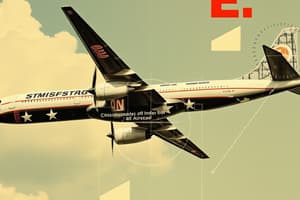Podcast
Questions and Answers
Which of the following is NOT a factor contributing to the complexity of aircraft movements in a given airspace?
Which of the following is NOT a factor contributing to the complexity of aircraft movements in a given airspace?
- The presence of specific geographical features in the airspace (correct)
- The types of aircraft operating in the airspace
- The number of aircraft operating in the airspace
- The variety of flight operations occurring in the airspace
Which airspace classification is typically associated with areas of high complexity?
Which airspace classification is typically associated with areas of high complexity?
- Class E airspace
- Class B airspace
- Uncontrolled airspace (Class G)
- Controlled airspace (correct)
What is the primary reason for establishing different airspace classifications?
What is the primary reason for establishing different airspace classifications?
- To minimize the risk of mid-air collisions (correct)
- To facilitate the development of new technologies for air traffic control
- To ensure efficient communication between pilots and ATC
- To optimize the use of airspace resources
Which of the following is NOT a characteristic of controlled airspace?
Which of the following is NOT a characteristic of controlled airspace?
What is the main difference between controlled and uncontrolled airspace in terms of pilot responsibility?
What is the main difference between controlled and uncontrolled airspace in terms of pilot responsibility?
Which of the following best describes the relationship between airspace complexity and the need for ATC intervention?
Which of the following best describes the relationship between airspace complexity and the need for ATC intervention?
Why are see-and-avoid practices essential in uncontrolled airspace?
Why are see-and-avoid practices essential in uncontrolled airspace?
What is the primary safety concern addressed by the establishment of controlled airspace?
What is the primary safety concern addressed by the establishment of controlled airspace?
Which of the following best describes the purpose of airspace classification?
Which of the following best describes the purpose of airspace classification?
What is the primary role of ATC in controlled airspace?
What is the primary role of ATC in controlled airspace?
The level of complexity in a given airspace directly influences the classification of that airspace.
The level of complexity in a given airspace directly influences the classification of that airspace.
The primary safety concern addressed by airspace classifications is to prevent mid-air collisions.
The primary safety concern addressed by airspace classifications is to prevent mid-air collisions.
Airspace classifications are a static system that does not change based on real-time traffic density.
Airspace classifications are a static system that does not change based on real-time traffic density.
The higher the complexity of aircraft movements, the greater the need for see-and-avoid practices.
The higher the complexity of aircraft movements, the greater the need for see-and-avoid practices.
Uncontrolled airspace is always designated as Class G, regardless of the complexity of aircraft movements.
Uncontrolled airspace is always designated as Class G, regardless of the complexity of aircraft movements.
Airspace classification plays a role in determining the specific operational requirements for pilots.
Airspace classification plays a role in determining the specific operational requirements for pilots.
The types of aircraft operating in a given airspace do not impact the classification of that airspace.
The types of aircraft operating in a given airspace do not impact the classification of that airspace.
The United States utilizes a system of airspace classifications from Class A to Class E, with Class E being the least restrictive.
The United States utilizes a system of airspace classifications from Class A to Class E, with Class E being the least restrictive.
Pilots operating in Class G airspace rely solely on visual separation and communication with other aircraft.
Pilots operating in Class G airspace rely solely on visual separation and communication with other aircraft.
The complexity of aircraft movements is directly proportional to the number of aircraft present in a given airspace.
The complexity of aircraft movements is directly proportional to the number of aircraft present in a given airspace.
How does traffic density influence the classification of airspace?
How does traffic density influence the classification of airspace?
What are the implications of operating in high-complexity airspace for pilots?
What are the implications of operating in high-complexity airspace for pilots?
Explain the significance of air traffic control (ATC) in managing aircraft movements in controlled airspace.
Explain the significance of air traffic control (ATC) in managing aircraft movements in controlled airspace.
How do pilots' responsibilities differ in controlled versus uncontrolled airspace?
How do pilots' responsibilities differ in controlled versus uncontrolled airspace?
What factors contribute to the complexity of airspace and its classification?
What factors contribute to the complexity of airspace and its classification?
Discuss the role of airspace classification in preventing mid-air collisions.
Discuss the role of airspace classification in preventing mid-air collisions.
In what ways do different classes of controlled airspace cater to varying levels of complexity?
In what ways do different classes of controlled airspace cater to varying levels of complexity?
What are the potential challenges pilots face when navigating uncontrolled airspace?
What are the potential challenges pilots face when navigating uncontrolled airspace?
Why is effective communication critical in controlled airspace?
Why is effective communication critical in controlled airspace?
What is the relationship between aircraft type and airspace classification?
What is the relationship between aircraft type and airspace classification?
Study Notes
Aircraft Movement and Airspace Classification
- The complexity of aircraft movements significantly influences airspace classification.
- Aircraft types range from small single-engine planes to large commercial jets, each with unique behaviors, limitations, and requirements.
- Traffic volume, aircraft mix, weather, airport proximity, and flight altitude contribute to airspace complexity.
- At busier international airports, Class B airspace is necessary for managing high traffic densities and ensuring safety.
- Class G airspace is typical for rural, uncontrolled environments with minimal traffic.
Role of Air Traffic Control (ATC)
- ATC acts as traffic managers for airspace, adapting instructions for various aircraft types and operational environments.
- Continuous adjustments to airspace classifications are made to reflect changes in flight operations and technological advancements.
- The interrelationship between airspace classification, IFR (Instrument Flight Rules), and VFR (Visual Flight Rules) provides a framework for minimizing collision risks.
Safety and Airspace Management
- Safety requirements shape airspace classifications, focusing on protecting pilots and the public.
- The establishment and modification of airspace classifications depend on various factors, including traffic density and navigation services.
- High-density areas require more controlled airspace, managed to prevent collisions and streamline operations.
Dynamics of Airspace Classification
- Evolving technology, such as increased drone operations, presents new challenges in determining airspace classifications.
- Temporary Flight Restrictions may be implemented during large public gatherings to adjust airspace for enhanced safety.
- Rapid reclassification can occur after incidents to mitigate risks in affected areas.
Continuous Assessment of Airspace
- Aviation authorities must regularly reassess airspace classifications in response to changing traffic patterns and emerging technologies.
- The dynamic nature of airspace classification ensures the ongoing safety and efficiency of air traffic management.
- Future studies will focus on identifying airspace classifications on aviation maps, emphasizing their role in flight planning.
Key Takeaways
- Complexity of aircraft movements necessitates regulated airspace for safety.
- Controlled airspace allows for ATC intervention and separation services, essential in busy environments.
- Understanding airspace classifications is critical for flight preparation, operational safety, and efficient traffic management.
Aircraft Movement and Airspace Classification
- The complexity of aircraft movements significantly influences airspace classification.
- Aircraft types range from small single-engine planes to large commercial jets, each with unique behaviors, limitations, and requirements.
- Traffic volume, aircraft mix, weather, airport proximity, and flight altitude contribute to airspace complexity.
- At busier international airports, Class B airspace is necessary for managing high traffic densities and ensuring safety.
- Class G airspace is typical for rural, uncontrolled environments with minimal traffic.
Role of Air Traffic Control (ATC)
- ATC acts as traffic managers for airspace, adapting instructions for various aircraft types and operational environments.
- Continuous adjustments to airspace classifications are made to reflect changes in flight operations and technological advancements.
- The interrelationship between airspace classification, IFR (Instrument Flight Rules), and VFR (Visual Flight Rules) provides a framework for minimizing collision risks.
Safety and Airspace Management
- Safety requirements shape airspace classifications, focusing on protecting pilots and the public.
- The establishment and modification of airspace classifications depend on various factors, including traffic density and navigation services.
- High-density areas require more controlled airspace, managed to prevent collisions and streamline operations.
Dynamics of Airspace Classification
- Evolving technology, such as increased drone operations, presents new challenges in determining airspace classifications.
- Temporary Flight Restrictions may be implemented during large public gatherings to adjust airspace for enhanced safety.
- Rapid reclassification can occur after incidents to mitigate risks in affected areas.
Continuous Assessment of Airspace
- Aviation authorities must regularly reassess airspace classifications in response to changing traffic patterns and emerging technologies.
- The dynamic nature of airspace classification ensures the ongoing safety and efficiency of air traffic management.
- Future studies will focus on identifying airspace classifications on aviation maps, emphasizing their role in flight planning.
Key Takeaways
- Complexity of aircraft movements necessitates regulated airspace for safety.
- Controlled airspace allows for ATC intervention and separation services, essential in busy environments.
- Understanding airspace classifications is critical for flight preparation, operational safety, and efficient traffic management.
Aircraft Movement and Airspace Classification
- The complexity of aircraft movements significantly influences airspace classification.
- Aircraft types range from small single-engine planes to large commercial jets, each with unique behaviors, limitations, and requirements.
- Traffic volume, aircraft mix, weather, airport proximity, and flight altitude contribute to airspace complexity.
- At busier international airports, Class B airspace is necessary for managing high traffic densities and ensuring safety.
- Class G airspace is typical for rural, uncontrolled environments with minimal traffic.
Role of Air Traffic Control (ATC)
- ATC acts as traffic managers for airspace, adapting instructions for various aircraft types and operational environments.
- Continuous adjustments to airspace classifications are made to reflect changes in flight operations and technological advancements.
- The interrelationship between airspace classification, IFR (Instrument Flight Rules), and VFR (Visual Flight Rules) provides a framework for minimizing collision risks.
Safety and Airspace Management
- Safety requirements shape airspace classifications, focusing on protecting pilots and the public.
- The establishment and modification of airspace classifications depend on various factors, including traffic density and navigation services.
- High-density areas require more controlled airspace, managed to prevent collisions and streamline operations.
Dynamics of Airspace Classification
- Evolving technology, such as increased drone operations, presents new challenges in determining airspace classifications.
- Temporary Flight Restrictions may be implemented during large public gatherings to adjust airspace for enhanced safety.
- Rapid reclassification can occur after incidents to mitigate risks in affected areas.
Continuous Assessment of Airspace
- Aviation authorities must regularly reassess airspace classifications in response to changing traffic patterns and emerging technologies.
- The dynamic nature of airspace classification ensures the ongoing safety and efficiency of air traffic management.
- Future studies will focus on identifying airspace classifications on aviation maps, emphasizing their role in flight planning.
Key Takeaways
- Complexity of aircraft movements necessitates regulated airspace for safety.
- Controlled airspace allows for ATC intervention and separation services, essential in busy environments.
- Understanding airspace classifications is critical for flight preparation, operational safety, and efficient traffic management.
Studying That Suits You
Use AI to generate personalized quizzes and flashcards to suit your learning preferences.
Related Documents
Description
Learn about the factors that influence airspace classification, including aircraft types, traffic volume, and weather. Understand the complexity of managing air traffic at busy international airports.




